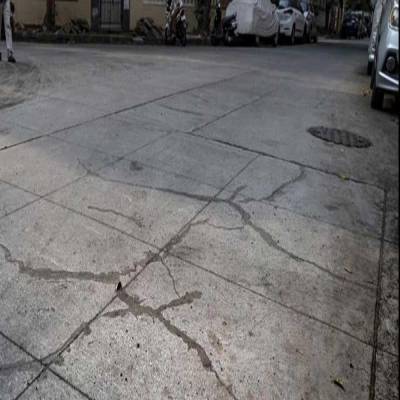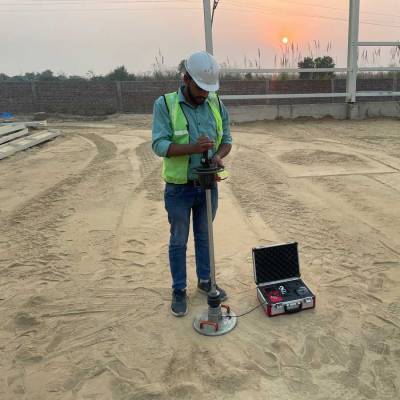- Home
- Real Estate
- Buildings: Criteria for material selection and testing parameters
Buildings: Criteria for material selection and testing parameters
That said, Prof Manu Santhanam, Department of Civil Engineering, IIT-Madras, avers, “RMC has an advantage in terms of the quality of the blend used, compared to site-mixed concrete.”
Further, speaking from his experience over the years and data analysis, Dr Niranjan Hiranandani, Founder & Managing Director, Hiranandani Group and President, NAREDCO, believes mixed concrete on site that has been produced with a scientific and systematic way along with appropriate R&D helps establish a system in place that ensures better quality. “Further, the ‘garbage-in, garbage-out’ concept also applies to the production of concrete,” he contends.
“Hence, it is important to set criteria for the right selection of material, testing parameters and acceptance criteria.”
Agreeing that many smaller-scale projects still use hand-mixed concrete at site, Deepak Suvarna, Chief Projects Officer-Head Projects, Mahindra Lifespaces Developers, says, “If not supervised properly, this does not fulfil the requirements of the Indian Standards.” He adds that almost all leading developers use automated concrete batching plants, which have computerised control for mixing ingredients. “This ensures that consistent concrete is produced in minimum time with little deviation.” And Pradeep Jain, Chairman, Parsvnath Developers, confirms, “If concrete mixing is done in a controlled environment with adequate supervision, it can produce good results.”
Role of construction chemicals
If the material used is not of required standards itself, the inclusion of plasticisers, waterproofing chemicals and rust-preventing chemicals in concrete mixtures can help cover up the possible shortcomings in concrete mixing.
In Dr Hiranandani’s view, construction chemicals enhance the properties of concrete in terms of durability, workability and strength. Indeed, as demand for bigger and stronger structures started increasing, ordinary elements such as concrete have required additional modification to deliver more strength in various climatic and critical conditions. And that’s where construction chemicals have played a pivotal role. Samyak Jain points to a group of chemicals that have helped keep up with the pace of development by making the construction of structures possible by easy workability, upgrading strength, augmenting performance in extreme environmental conditions and maintaining structures in adverse climatic conditions.
Mahindra Lifespaces Developers uses construction chemicals that enhance the properties of concrete such as early strength development, reduced setting time and improved workability through higher slump or flow. “These chemicals alter the product to suit the needs of the project,” says Suvarna, adding that waterproofing chemicals help protect the structure and prevent seepage. Admixtures modify concrete properties and some injection grouts make it watertight. For his part, Pradeep Jain says plasticisers, waterproofing chemicals and rust-preventing chemicals in concrete mixtures are inclusions that help cover up possible shortcomings in concrete mixing.
In Prof Santhanam’s view, these are essential ingredients of modern concrete. “Superplasticisers help optimise cement content in concrete and provide water reduction,” he says. “Other construction chemicals bring about niche characteristics in the material.” However, he emphasises that these chemicals are not a remedy for bad-quality materials in concrete or an inappropriate design mix. “They only help to make good concrete better.”
Here, Dr Pramod Kumar Gupta, Professor, Structural Engineering, Department of Civil Engineering, IIT-Roorkee, also cautions that construction chemicals may be used to obtain the desired engineering properties of concrete for the desired purpose, but if not mixed intelligently and properly, they may hamper the properties.
SHRIYAL SETHUMADHAVAN
- Concreting
- Samyak Jain
- Siddha Group
- ready-mix concrete
- site-mixed concrete
- high-rise structures
- Prof Manu Santhanam
- IIT-Madras
- Dr Niranjan Hiranandani
- Hiranandani Group
- NAREDCO
- Deepak Suvarna
- Mahindra Lifespaces Developers
- Pradeep Jain
- Parsvnath Developers
- RMC
- automated concrete batching plants
- Indian Standards
- plasticisers
- waterproofing chemicals
- rust-preventing chemicals
- concrete mixtures
Concreting operations such as mixing, transporting, placing, compaction and curing are important to deliver optimal quality. The complete strength of a structure is directly proportional to the properties and quality of materials and the quality of construction. Samyak Jain, Director, Siddha Group, refers to two types of concrete that construction companies use: Ready-mix concrete (RMC) and site-mixed concrete. “The quality of both types is dependent on the number of formulas and steps,” he says. While application of RMC is recommended for construction of high-rise structures, especially during lack of proper logistical support, the quality of concrete mixed on site can be enhanced with stricter supervision and correct inputs. That said, Prof Manu Santhanam, Department of Civil Engineering, IIT-Madras, avers, “RMC has an advantage in terms of the quality of the blend used, compared to site-mixed concrete.” Further, speaking from his experience over the years and data analysis, Dr Niranjan Hiranandani, Founder & Managing Director, Hiranandani Group and President, NAREDCO, believes mixed concrete on site that has been produced with a scientific and systematic way along with appropriate R&D helps establish a system in place that ensures better quality. “Further, the ‘garbage-in, garbage-out’ concept also applies to the production of concrete,” he contends. “Hence, it is important to set criteria for the right selection of material, testing parameters and acceptance criteria.” Agreeing that many smaller-scale projects still use hand-mixed concrete at site, Deepak Suvarna, Chief Projects Officer-Head Projects, Mahindra Lifespaces Developers, says, “If not supervised properly, this does not fulfil the requirements of the Indian Standards.” He adds that almost all leading developers use automated concrete batching plants, which have computerised control for mixing ingredients. “This ensures that consistent concrete is produced in minimum time with little deviation.” And Pradeep Jain, Chairman, Parsvnath Developers, confirms, “If concrete mixing is done in a controlled environment with adequate supervision, it can produce good results.” Role of construction chemicals If the material used is not of required standards itself, the inclusion of plasticisers, waterproofing chemicals and rust-preventing chemicals in concrete mixtures can help cover up the possible shortcomings in concrete mixing. In Dr Hiranandani’s view, construction chemicals enhance the properties of concrete in terms of durability, workability and strength. Indeed, as demand for bigger and stronger structures started increasing, ordinary elements such as concrete have required additional modification to deliver more strength in various climatic and critical conditions. And that’s where construction chemicals have played a pivotal role. Samyak Jain points to a group of chemicals that have helped keep up with the pace of development by making the construction of structures possible by easy workability, upgrading strength, augmenting performance in extreme environmental conditions and maintaining structures in adverse climatic conditions. Mahindra Lifespaces Developers uses construction chemicals that enhance the properties of concrete such as early strength development, reduced setting time and improved workability through higher slump or flow. “These chemicals alter the product to suit the needs of the project,” says Suvarna, adding that waterproofing chemicals help protect the structure and prevent seepage. Admixtures modify concrete properties and some injection grouts make it watertight. For his part, Pradeep Jain says plasticisers, waterproofing chemicals and rust-preventing chemicals in concrete mixtures are inclusions that help cover up possible shortcomings in concrete mixing. In Prof Santhanam’s view, these are essential ingredients of modern concrete. “Superplasticisers help optimise cement content in concrete and provide water reduction,” he says. “Other construction chemicals bring about niche characteristics in the material.” However, he emphasises that these chemicals are not a remedy for bad-quality materials in concrete or an inappropriate design mix. “They only help to make good concrete better.” Here, Dr Pramod Kumar Gupta, Professor, Structural Engineering, Department of Civil Engineering, IIT-Roorkee, also cautions that construction chemicals may be used to obtain the desired engineering properties of concrete for the desired purpose, but if not mixed intelligently and properly, they may hamper the properties. SHRIYAL SETHUMADHAVAN





















